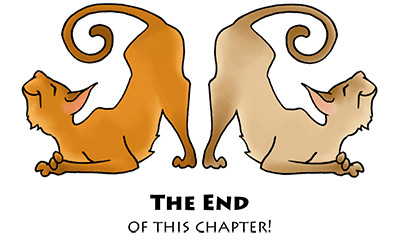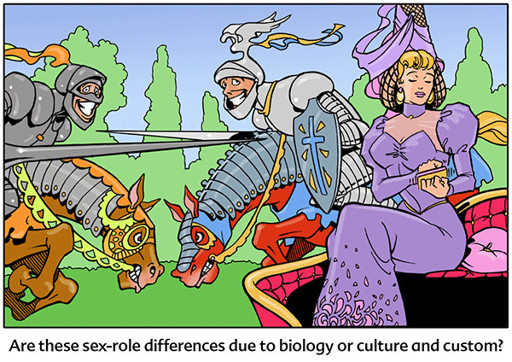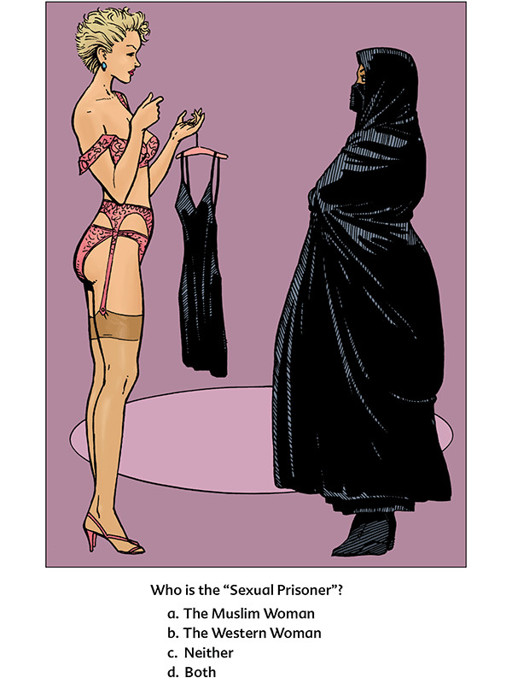The Guide to Getting It On (143 page)
Read The Guide to Getting It On Online
Authors: Paul Joannides
Tags: #Self-Help, #Sexual Instruction, #Sexuality

The “Honey Do” Influence:
A guy would have less resistance to wearing girls’ bikini bottoms if his wife said, “Honey, I think you’ll look sexy in these.” This fact wasn’t lost on the underwear manufacturers, as the ads with the male athletes in their bikini briefs were clearly aimed at women.
Penis-Over-The-Top Factor:
The transition to bikini underwear for men had a good deal of practical significance. That’s because when we pee, a lot of us don’t pull the penis through the fly in men’s briefs or boxers. Instead, we yank the elastic waistband down and plop the penis over the top. So the fly is totally useless for a lot of men and having the lower waistband makes the process of peeing easier.
Briefs and Bras in Perspective
Publications in gender studies tend to focus on subjects like violence, rape, and the truly awful things that some people do to others. They would consider our look at men’s and women’s underwear superficial. However, “superficial” means “on the outside.” In the last two chapters, we took your blouses off and pulled your pants down.
If we had a gender studies course at Goofy Foot University (a.k.a. G F-U!), students would spend the first week playing with Barbie, GI Joe, Legos, and Matchbox Cars. They would then be asked to consider the relationships between play and gender identification. The next week, they would have to strip down to their undies and free-associate about what’s masculine and feminine. Hopefully, one of the women would be wearing a Granny Bra.
The most important lesson, however, is that a hundred years ago, no one would have been able to predict that the bra would ever be sexy. And as little as fifty years ago, no one would have been able to predict that men would feel manly wearing women’s bikini bottoms. Look at all of the effort that went into weaving these pieces of cloth into the sexual fabric of our culture.
A Note on Different Water Cultures:
Most male surfers wouldn’t be caught dead in Speedos. The only commonality between many male swimmers and surfers seems to be water, and the water of the former smells like chlorine while the water of the latter tastes like salt.

CHAPTER
70
What’s Masculine, Feminine & Erotic?
T
he thinking in some academic circles is that masculinity and femininity are constructed by society. And once you start chipping away at what’s masculine and what’s feminine in different cultures, you can’t help but agree, at least a little. Men and women may arrive at things like sexual orientation in different ways, and our brains might even process certain aspects of sexuality differently, but culture plays a big role in determining our sex roles. This chapter takes a brief look at matters that can be incredibly complex.

Masculinity, Then and Now
A little more than a hundred years ago, men who didn’t have much money worked in jobs that required a good deal of physical labor. Unlike today, a lean, buff man with sexy muscles did not get that way from working out at a gym. His well-defined muscles were usually the result of a low-paying job. As a result, a well-dressed man with a pot belly was a better catch for an attractive young woman in the year 1900. The big belly and nice clothes meant being able to protect your wife and children from an economy that suffered frequent and wicked downturns. They meant a woman wouldn’t have to work outside the home, which was significant when the best jobs most women could get in 1900 were a domestic servant or a seamstress, working long hours at very low pay. To earn more, she might need to become a prostitute.
Have things changed just a bit? Well, not with the economy, but with the muscles. Nowadays we assume that most men with buff muscles have enough leisure time to work out. It’s unlikely that someone who is working two jobs will be able to make time for the gym. A guy who has a job as computer programmer may work out at the gym in an attempt to hide the fact that his biggest physical challenge at work is opening up his laptop. And the young woman of olde who may have viewed Mr. Portly as a good catch might very well be working out at the gym today with Mr. Buff and making as much money as he is. Such an independent woman would not have been considered “feminine” a hundred years ago. In 1900, feigning frailty was an important element of femininity.

What Different Societies Have to Say
Each culture has its own definition of what’s masculine, feminine and erotic. Here are some examples of how these definitions differ from culture to culture, year to year:
- Women in Muslim cultures cover themselves from head to toe when appearing in public. Women in Hollywood show up wearing a few molecules of fabric, designed to tease rather than cover. The women in Hollywood claim that their Muslim counterparts are sexual prisoners. The Muslim women say the real prisoners are the females in Hollywood. One female reader says that neither women are sexual prisoners, since they both use sex to control the people around them!

- In Japan, it’s a common practice for people to strip naked and bathe together. Nobody finds this kind of public nudity to be erotic or shameful, but Lord help two Japanese who kiss in public, at least until recently. In our society, it’s nearly the opposite, with kissing being fine and nudity an offense.
- Kim Edwards is a woman who taught English in a rigid Islamic country for two years and then moved to Japan. After a few years in an Islamic country, Ms. Edwards found herself at odds with her own body. When she moved to Japan, she was surprised to find herself treated as a normal person no matter what she wore. She could even bathe naked in public bathhouses, while she could have been stoned to death for doing this in an Islamic country. In Muslim countries, women are obliged to cover their bodies to live a chaste and modest life. However, within the confines of marriage, Muslim women are encouraged to enjoy their sexuality.
- During the Summer Olympics, male gymnasts from the Russian team often celebrated good performances by kissing other male team members on the lips. Our U.S. male gymnasts wouldn’t be caught dead doing that, not in public anyway.
- In America, many straight women now wear their hair short, and many straight men wear their hair long. Sixty years ago, this meant that you were homosexual. And think of the public outcry if a 1950s professional baseball player appeared in billboard ads wearing a pair of red bikini briefs; or if his 1950s beehive-coiffed girlfriend went to the grocery store wearing Doc Martens and male boxers. Or what if a straight American male wore a pierced earring before the 1980s, or trimmed or shaved his pubic hair?
- In America, there is nothing unusual about an unmarried 18-year-old woman having sex; but in some parts of the Middle East, India and Pakistan, such a woman risks harming the honor of her family. In rural villages, she might be murdered by her own family members in what is known as an “honor killing” to protect the family name. Fortunately, the practice is not as common as it was a few decades ago, but it still happens.
- Less than a decade ago, a consultant to
The Guide
was invited to India to speak on “Alternatives to Wife Burning.” It seems that if a husband and his mother are unhappy with his wife, fatal “kitchen accidents” can happen with few legal consequences. What the consultant found most surprising was that it was the men at this meeting, rather than the women, who welcomed the nonviolent alternatives. - In Africa, millions of women have their clitorises and inner labia crudely cut out of their bodies as children. This type of “surgery” has been considered an important passage to womanhood which many African mothers have done to their young daughters. In the West, a mother who did such a thing to her daughters would be put in prison. Of course, African women might claim that the clitoridectomy is just as cosmetic and feminine as our Western penchant for mutilating female bodies with breast implants. Who knows what an African woman might say about liposuction or labiaplasty.
- In the early 1800s, Americans believed that a woman’s sexual pleasure was as important as men’s pleasure. Then, from the late 1800s until the 1960s, it was considered unfeminine for women in our society to enjoy sex as much as men. Valuing sex became a masculine trait, and some women even believed that it was unladylike to have orgasms.
- In parts of the world where virginity is highly valued, family members will wait outside the newly-wed couple’s door on the night of the wedding to confirm there is “blood on the sheets.” The marriage can be annulled if the bride can’t “prove” her virginity or if the groom fails to perform.
- In North America and Europe, we view a woman’s sexual wetness as a good thing—the wetter, the better. Vaginal wetness is the female equivalent of an erect penis, a sign that a woman is turned on and ready to romp. But in Zimbabwe and Zaire, women traditionally worked at drying out their vaginas before a penis went in. In these countries, a wet vagina was traditionally viewed as dirty, smelly and possibly infected. It also causes embarrassing sounds during intercourse and risks being seen as a sign of infidelity. Here we use one of many brands of sex lube if a vagina isn’t wet enough.
Masculinity & Femininity
For many of us, masculinity and femininity are concepts that make all the sense in the world as long as you don’t try to define them. For example, people in this country think of masculine as being rough-and-tumble and feminine as being dainty and nurturing. Yet this isn’t nearly as true in preschools that require girls to wear the same kind of clothes as boys. Once freed from wearing dainty outfits, a lot of little girls get rough-and-tumble too.